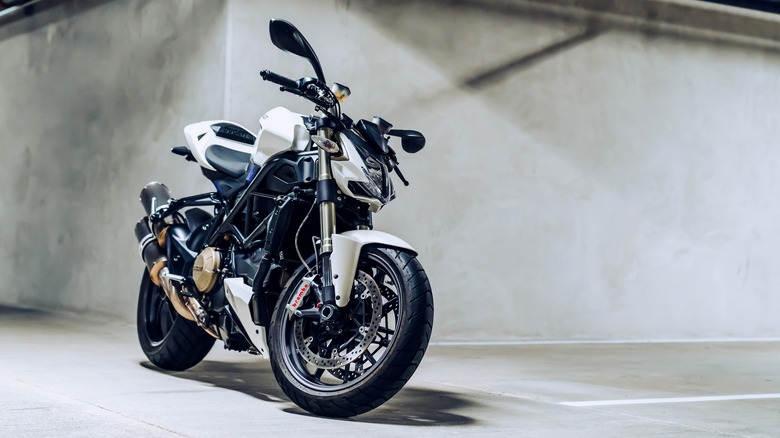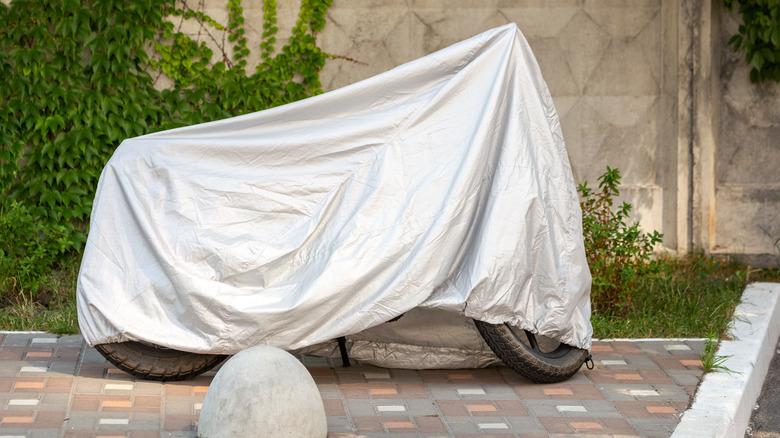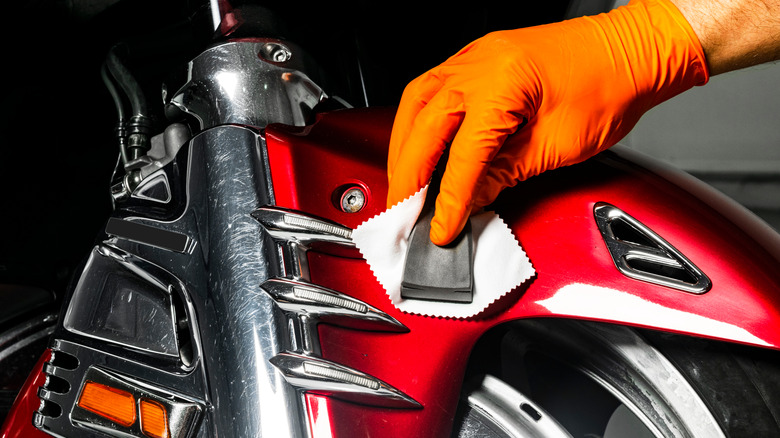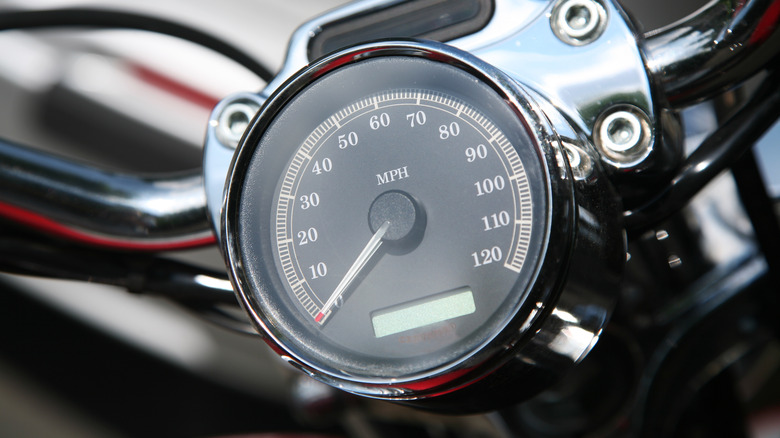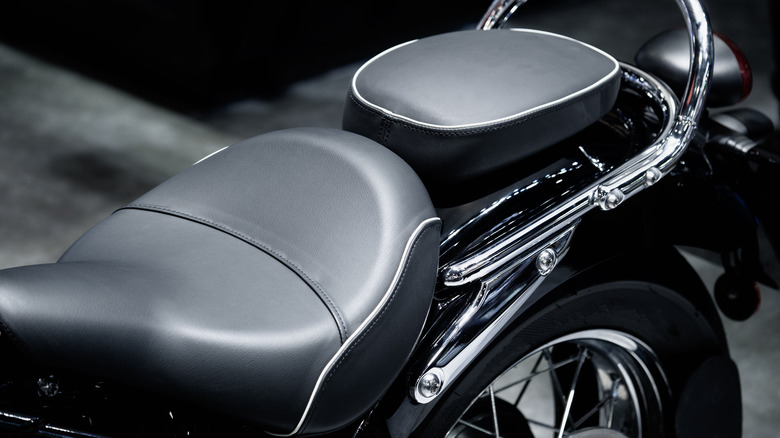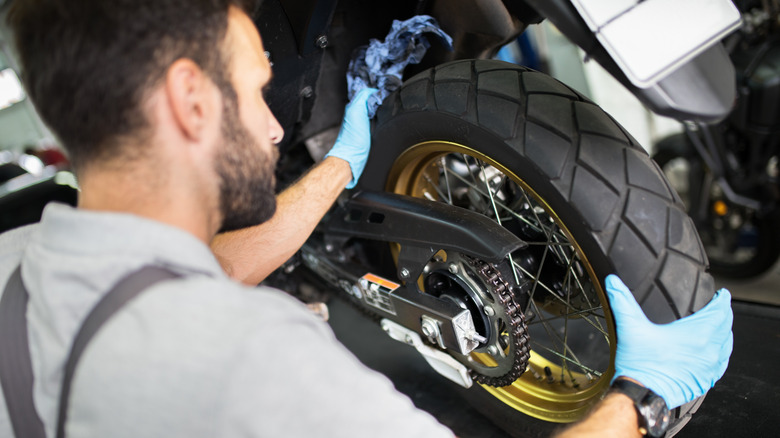5 Tips & Tricks To Keep Your Motorcycle Looking Brand New
Few things make a statement quite like riding up on a brand new, sparkling motorcycle, fresh off the lot. Sitting on something that glitters in the sunlight as you cruise down the highway almost makes you look like some kind of supernatural comet. Of course, this effect usually only lasts for the first few days after you get your new bike. After you've put it through its paces and driven it here and there, the natural newly-purchased shine gradually starts to fade away, leaving an old motorcycle in its place. Plain old motorcycles are still cool, just not as cool.
If you want to preserve that new ride shine well into the bike's later years, it's on you to take the utmost care of it. Obviously, the baseline responsibility for maintaining a bike's appearance is regular washing and automotive upkeep, but those shouldn't be the only tricks in your proverbial toolbox. There are a variety of relatively simple moves you can make to keep your bike's ephemeral glow, even years into your ownership of it.
Proper parking and storage
The bedrock rule of ensuring a motorcycle's longevity can be boiled down to three words: location, location, location. Motorcycles may be fairly sturdy vehicles, but that doesn't mean you can just leave them out on the street like your childhood bicycle. Improper motorcycle storage, particularly leaving it outside and/or off of pavement, exposes it to the elements. Dirt and mud gets stuck to the tires, rain pours down from above, the sun bakes the paint job, and more. All in all, leaving your ride outside unprotected is one of the worst things you can do to it, especially during the cold and wet winter months.
If at all possible, you should store your motorcycle in an enclosed, temperature-controlled space, i.e., a garage. Keeping your motorcycle indoors protects it from the elements, only to be exposed when you take it out to ride it. If you don't have room in your garage, or a garage at all, you can still store your motorcycle in a driveway so long as you employ protective covers. A light, weather-resistant tarp will keep the icky stuff away, and can be easily removed when it's time to hit the road. Or, if you don't mind splurging a bit, you can purchase a collapsible shelter for your motorcycle, setting it up in a driveway to serve as a spacious canopy.
Reapply the paint
A major factor in a brand-new motorcycle's wow factor is its fresh paint job. A completely unmarred coat of paint on a motorcycle gives it that lovely shine, twinkling like stars in the sunlight. Sadly, as you drive your motorcycle around, that paint will gradually fade as it's exposed to UV baking from the sun and bug splatters on the highway. Eventually, the paint will turn dull and muted, which definitely doesn't make your ride look attractive.
If your motorcycle's paint has become dulled, chipped, or otherwise diminished, you can either touch it back up yourself or bring it to a professional customizer to have them do it. Reapplying paint isn't just about covering your bike in a brighter color; the process also sands down gathered chips, bumps, and other assorted imperfections, ensuring the new coat of paint is flat and uniform. A fresh coat of paint is often followed up by a good waxing, which both helps to seal in the paint's color and create a barrier between the paint and any would-be contaminants, ensuring that shine lasts for as long as possible. Plus, repainting your bike is a great opportunity for some creative customization.
Use UV protectant on plastic components
In addition to a fresh coat of paint and wax, there are additional products you can use to improve your motorcycle's longevity in the face of the harsh elements of the road. For one thing, no matter where you drive or how you drive, your ride is almost always going to get a major blast of direct sunlight. While washing and waxing can help to protect your bike's metal components from the sun, any plastic components like dashboard gauges can still get baked by the sunlight, turning an unsightly yellow color.
To protect the plastic surfaces on your motorcycle, you should use a can of UV protectant. These sprayable products are meant to go on in the midst of a motorcycle detailing, creating a separate defensive layer on plastic components that guards them from intense UV light. A good can of UV protectant costs around $15, and can be sprayed onto gauges, windscreens, instrument faces, and any other plastic bits on your ride. Just remember to wipe down any plastic components with a microfiber cloth before spraying, just so you don't accidentally seal the contaminants onto them.
Apply leather seat conditioner
The stark, dark color of a natural leather seat on a motorcycle makes for an excellent contrast against a sparkly paint job. It certainly doesn't hurt that cared-for leather is both comfortable to sit on and highly resistant to physical punishment. However, much like the metal and plastic components on your bike, even a leather seat isn't immune to the ravages of time. Without proper care, leather can start to wear out, becoming tough and uncomfortable and tearing open in places.
Leather seats need to be cared for in a very particular way, using specialized cleaners and conditioners. You can't just splash leather with water and call it a day; you need to carefully work cleaning solutions into the leather to get into its various nooks and crannies in order to remove any stains. Afterward, conditioner should be applied to moisturize the leather, helping to keep its natural bounce and resilience. Remember, leather comes from a living animal, and must be treated like a living thing to get the best possible performance from it.
Replace worn-out components
Keeping your motorcycle looking like new isn't just about washing it and applying cleaners and protectants. Like any mechanical device, a motorcycle is a complex system of interlocking parts, all of which must be in proper working order to ensure the proper functioning of the whole. However, as a vehicle that regularly endures physical punishment, the smaller, more fragile components of a motorcycle can start to wear out beyond the point of restoration. Nothing makes a motorcycle look run down like busted parts, so when the time comes, you'll need to swap them out for fresh ones.
There are a handful of components on your motorcycle that will likely need to be replaced after you've after you've owned your motorcycle for long enough. These components include things like brake pads, motor chains, spark plugs, air filters, and perhaps most obviously, tires. Even if these parts aren't immediately visible at a glance, poor functioning can have knock-on effects on the rest of your bike's appearance, such as oil and carbon buildup on the spark plugs marring the sides of the engine. Replacing these components when they become too worn out not only helps to keep your motorcycle looking factory-fresh, but also ensures the continued safe operation of your vehicle.
